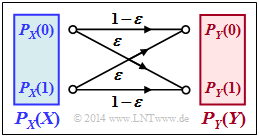Difference between revisions of "Aufgaben:Exercise 3.10: Mutual Information at the BSC"
From LNTwww
| Line 1: | Line 1: | ||
| − | {{quiz-Header|Buchseite= | + | {{quiz-Header|Buchseite=Information_Theory/Application_to_Digital_Signal_Transmission |
}} | }} | ||
Revision as of 09:17, 24 September 2021
We consider the Binary Symmetric Channel $\rm (BSC)$. The parameter values are valid for the whole exercise:
- Crossover probability: $\varepsilon = 0.1$,
- Probability for $0$: $p_0 = 0.2$,
- Probability for $1$: $p_1 = 0.8$.
Thus the probability mass function of the source is: $P_X(X)= (0.2 , \ 0.8)$ and for the source entropy applies:
- $$H(X) = p_0 \cdot {\rm log}_2 \hspace{0.1cm} \frac{1}{p_0} + p_1\cdot {\rm log}_2 \hspace{0.1cm} \frac{1}{p_1} = H_{\rm bin}(0.2)={ 0.7219\,{\rm bit}} \hspace{0.05cm}.$$
The task is to determine:
- the probability function of the sink:
- $$P_Y(Y) = (\hspace{0.05cm}P_Y(0)\hspace{0.05cm}, \ \hspace{0.05cm} P_Y(1)\hspace{0.05cm}) \hspace{0.05cm},$$
- the joint probability function:
- $$P_{XY}(X, Y) = \begin{pmatrix} p_{00} & p_{01}\\ p_{10} & p_{11} \end{pmatrix} \hspace{0.05cm},$$
- the mutual information:
- $$I(X;Y) = {\rm E} \hspace{-0.08cm}\left [ \hspace{0.02cm}{\rm log}_2 \hspace{0.1cm} \frac{P_{XY}(X, Y)} {P_{X}(X) \cdot P_{Y}(Y) }\right ] \hspace{0.05cm},$$
- the equivocation:
- $$H(X \hspace{-0.1cm}\mid \hspace{-0.1cm} Y) = {\rm E} \hspace{0.02cm} \big [ \hspace{0.02cm} {\rm log}_2 \hspace{0.1cm} \frac{1}{P_{\hspace{0.03cm}X \mid \hspace{0.03cm} Y} (X \hspace{-0.05cm}\mid \hspace{-0.05cm} Y)} \big ] \hspace{0.05cm},$$
- the irrelevance:
- $$H(Y \hspace{-0.1cm}\mid \hspace{-0.1cm} X) = {\rm E} \hspace{0.02cm} \big [ \hspace{0.02cm} {\rm log}_2 \hspace{0.1cm} \frac{1}{P_{\hspace{0.03cm}Y \mid \hspace{0.03cm} X} (Y \hspace{-0.05cm}\mid \hspace{-0.05cm} X)} \big ] \hspace{0.05cm}.$$
Hints:
- The exercise belongs to the chapter Application to Digital Signal Transmission.
- Reference is made in particular to the page Mutual information calculation for the binary channel.
- In Exercise 3.10Z the channel capacity $C_{\rm BSC }$ of the BSC model is calculated.
- This results as the maximum mutual information $I(X;\ Y)$ by maximization with respect to the probabilities $p_0$ or $p_1 = 1 - p_0$.
Questions
Solution
(1) The following applies in general or with the numerical values $p_0 = 0.2$ and $\varepsilon = 0.1$ for the quantities sought:
- $$P_{XY}(0, 0) = p_0 \cdot (1 - \varepsilon) \hspace{0.15cm} \underline {=0.18} \hspace{0.05cm}, \hspace{0.5cm} P_{XY}(0, 1) = p_0 \cdot \varepsilon \hspace{0.15cm} \underline {=0.02} \hspace{0.05cm},$$
- $$P_{XY}(1, 0) = p_1 \cdot \varepsilon \hspace{0.15cm} \underline {=0.08} \hspace{0.05cm}, \hspace{1.55cm} P_{XY}(1, 1) = p_1 \cdot (1 - \varepsilon) \hspace{0.15cm} \underline {=0.72} \hspace{0.05cm}.$$
(2) In general:
- $$P_Y(Y) = \big [ {\rm Pr}( Y = 0)\hspace{0.05cm}, {\rm Pr}( Y = 1) \big ] = \big ( p_0\hspace{0.05cm}, p_1 \big ) \cdot \begin{pmatrix} 1 - \varepsilon & \varepsilon\\ \varepsilon & 1 - \varepsilon \end{pmatrix}.$$
This gives the following numerical values:
- $$ {\rm Pr}( Y = 0)= p_0 \cdot (1 - \varepsilon) + p_1 \cdot \varepsilon = 0.2 \cdot 0.9 + 0.8 \cdot 0.1 \hspace{0.15cm} \underline {=0.26} \hspace{0.05cm},$$
- $${\rm Pr}( Y = 1)= p_0 \cdot \varepsilon + p_1 \cdot (1 - \varepsilon) = 0.2 \cdot 0.1 + 0.8 \cdot 0.9 \hspace{0.15cm} \underline {=0.74} \hspace{0.05cm}.$$
(3) For the mutual information, according to the definition with $p_0 = 0.2$, $p_1 = 0.8$ and $\varepsilon = 0.1$:
- $$I(X;Y) = {\rm E} \hspace{-0.08cm}\left [ \hspace{0.02cm}{\rm log}_2 \hspace{0.08cm} \frac{P_{XY}(X, Y)} {P_{X}(X) \hspace{-0.05cm}\cdot \hspace{-0.05cm} P_{Y}(Y) }\right ] \hspace{0.3cm} \Rightarrow$$
- $$I(X;Y) = 0.18 \cdot {\rm log}_2 \hspace{0.1cm} \frac{0.18}{0.2 \hspace{-0.05cm}\cdot \hspace{-0.05cm} 0.26} + 0.02 \cdot {\rm log}_2 \hspace{0.08cm} \frac{0.02}{0.2 \hspace{-0.05cm}\cdot \hspace{-0.05cm} 0.74} + 0.08 \cdot {\rm log}_2 \hspace{0.08cm} \frac{0.08}{0.8 \hspace{-0.05cm}\cdot \hspace{-0.05cm} 0.26} + 0.72 \cdot {\rm log}_2 \hspace{0.08cm} \frac{0.72}{0.8 \hspace{-0.05cm}\cdot \hspace{-0.05cm} 0.74} \hspace{0.15cm} \underline {=0.3578\,{\rm bit}} \hspace{0.05cm}.$$
(4) With the source entropy $H(X)$ given, we obtain for the equivocation:
- $$H(X \hspace{-0.1cm}\mid \hspace{-0.1cm} Y) = H(X) - I(X;Y) = 0.7219 - 0.3578 \hspace{0.15cm} \underline {=0.3642\,{\rm bit}} \hspace{0.05cm}.$$
- However, one could also apply the general definition with the inference probabilities $P_{X|Y}(⋅)$ :
- $$H(X \hspace{-0.1cm}\mid \hspace{-0.1cm} Y) = {\rm E} \hspace{0.02cm} \left [ \hspace{0.05cm} {\rm log}_2 \hspace{0.1cm} \frac{1}{P_{\hspace{0.03cm}X \mid \hspace{0.03cm} Y} (X \hspace{-0.05cm}\mid \hspace{-0.05cm} Y)} \hspace{0.05cm}\right ] = {\rm E} \hspace{0.02cm} \left [ \hspace{0.05cm} {\rm log}_2 \hspace{0.1cm} \frac{P_Y(Y)}{P_{XY} (X, Y)} \hspace{0.05cm} \right ] \hspace{0.05cm}$$
- In the example, the same result $H(X|Y) = 0.3642 \ \rm bit$ is also obtained according to this calculation rule:
- $$H(X \hspace{-0.1cm}\mid \hspace{-0.1cm} Y) = 0.18 \cdot {\rm log}_2 \hspace{0.1cm} \frac{0.26}{0.18} + 0.02 \cdot {\rm log}_2 \hspace{0.1cm} \frac{0.74}{0.02} + 0.08 \cdot {\rm log}_2 \hspace{0.1cm} \frac{0.26}{0.08} + 0.72 \cdot {\rm log}_2 \hspace{0.1cm} \frac{0.74}{0.72} \hspace{0.05cm}.$$
(5) Correct is the proposed solution 2:
- In the case of disturbed transmission $(ε > 0)$ the uncertainty regarding the sink is always greater than the uncertainty regarding the source. One obtains here as a numerical value:
- $$H(Y) = H_{\rm bin}(0.26)={ 0.8268\,{\rm bit}} \hspace{0.05cm}.$$
- With error-free transmission $(ε = 0)$, on the other hand, $P_Y(⋅) = P_X(⋅)$ and $H(Y) = H(X)$ would apply.
(6) Here, too, the second proposed solution is correct:
- Because of $I(X;Y) = H(X) - H(X \hspace{-0.1cm}\mid \hspace{-0.1cm} Y) = H(Y) - H(Y \hspace{-0.1cm}\mid \hspace{-0.1cm} X)$ , $H(Y|X)$ is greater than $H(X|Y)$ by the same amount that $H(Y)$ is greater than $H(X)$:
- $$H(Y \hspace{-0.1cm}\mid \hspace{-0.1cm} X) = H(Y) -I(X;Y) = 0.8268 - 0.3578 ={ 0.469\,{\rm bit}} \hspace{0.05cm}$$
- Direct calculation gives the same result $H(Y|X) = 0.469\ \rm bit$:
- $$H(Y \hspace{-0.1cm}\mid \hspace{-0.1cm} X) = {\rm E} \hspace{0.02cm} \left [ \hspace{0.02cm} {\rm log}_2 \hspace{0.1cm} \frac{1}{P_{\hspace{0.03cm}Y \mid \hspace{0.03cm} X} (Y \hspace{-0.05cm}\mid \hspace{-0.05cm} X)} \right ] = 0.18 \cdot {\rm log}_2 \hspace{0.1cm} \frac{1}{0.9} + 0.02 \cdot {\rm log}_2 \hspace{0.1cm} \frac{1}{0.1} + 0.08 \cdot {\rm log}_2 \hspace{0.1cm} \frac{1}{0.1} + 0.72 \cdot {\rm log}_2 \hspace{0.1cm} \frac{1}{0.9} \hspace{0.05cm}.$$
